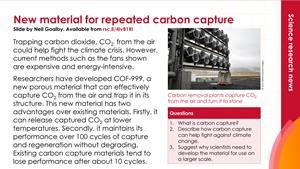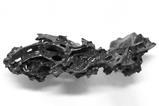Scientists could use this material thousands of times to help tackle the climate crisis
-

Download this
Use this story and the accompanying summary slide for a real-world context when studying methods to tackle climate change with your 14–16 learners.
Download the story as MS Word or PDF and the summary slide as MS PowerPoint or PDF.
An international team of chemists has made a deep yellow porous compound that can absorb carbon dioxide directly from the air in significant quantities.

Scientists are exploring the removal of carbon dioxide from the air, known as direct air capture, as a way to help combat the climate crisis. Even though carbon dioxide has reached dangerous levels from a climate perspective, it’s still only just over 0.04% of our atmosphere.
Once captured, they will securely store the carbon dioxide deep underground or use it for industrial applications. Selectively capturing this gas is technically challenging and expensive to do. Existing carbon capture materials only work effectively with concentrated sources of carbon dioxide, such as in the exhaust fumes of power plants and cement plants.
The team, led by Omar Yaghi at the University of California, Berkeley, has been designing porous covalent organic frameworks (COFs) for direct air capture. COFs are crystalline polymers with a large number of internal pores that can hold small gases such as carbon dioxide.
A bright future
One promising material is the deep yellow COF-999. The team says its reusability is one of its most exciting characteristics. Existing carbon capture materials tend to lose performance after about 10 cycles of capturing and releasing carbon dioxide molecules. The team tested COF-999 over 20 days using air piped into the lab from outside Berkeley’s chemistry department. ‘We cycled [COF-999] 100 times, and we didn’t see any degradation of behaviour,’ says Omar. He expects they could reuse the material ‘thousands and thousands’ of times. The scientists also found that COF-999 doesn’t need as much energy as many other carbon capture materials to release the captured gas.
The team is currently developing a scalable and green synthetic route to make COF-999 and related COFs at commercial scales. Omar is also planning to use artificial intelligence to design even better performing COFs for direct air capture.
Nina Notman
Reference
Z Zhou et al, Nature, 2024, 635, 96–101, (doi.org/10.1038/s41586-024-08080-x)
Download this
Summary slide with questions and the article for context when teaching your 14–16 learners about tackling climate change: rsc.li/3Zv3LB8
This article is adapted from Angeli Mehta’s in Chemistry World.
Downloads
Porous polymer captures carbon dioxide summary slide
Handout | PDF, Size 0.33 mbPorous polymer captures carbon dioxide student sheet
Handout | PDF, Size 0.25 mbPorous polymer captures carbon dioxide summary slide
Editable handout | PowerPoint, Size 4.21 mbPorous polymer captures carbon dioxide student sheet
Editable handout | Word, Size 1.13 mb
References
Z Zhou et al, Nature, 635, 96–101, 2024 (doi.org/10.1038/s41586-024-08080-x)














No comments yet